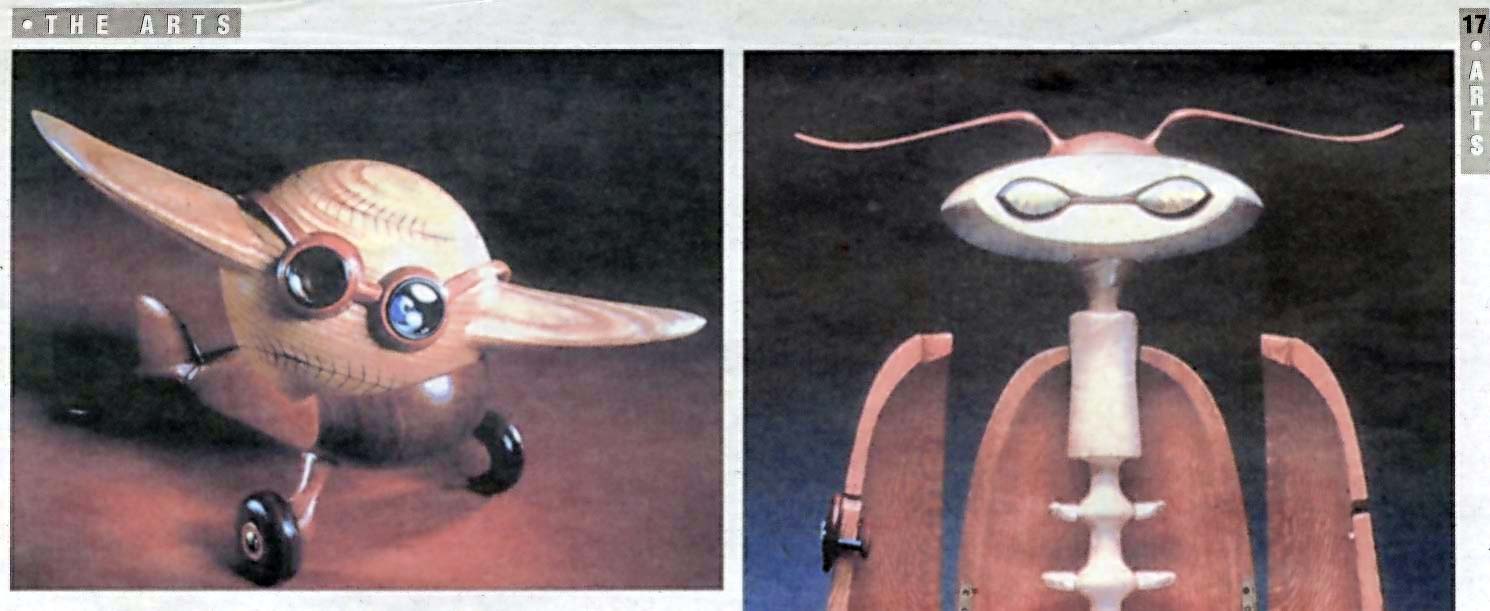For wood turner Michael Brolly, wood isn't alive enough. Which is why his sculptures at the Eerie Art Museum spout eyes, faces, wings, and goggles.
REVIEW BY JOHN EDWARDS
CONTRIBUTING WRITER
In the increasingly superstitious - what Carl Sagan called "demonhaunted"- world, inanimate matter is thought to emit force fields that extend out to the edge of the universe
and into the labyrinthine depths of eon
sciousness.
New agers, and even those who don't understand that they are new agers, talk about the "spiritual power" of small stones and mystic places. In "For the Time Being: A Christmas Oratorio," W.H. Auden warned that in an-age where "reason will be replaced by revelation, divine honours will be paid to shallow depressions in the earth, domestic
pets, [and ruined windmills ..."
I am not given to such imbuings of base matter with cosmic significance, nor do I think trees possess "wisdom," but it's hard not to feel the vibe of wood. Walk into any decently appointed library, and the cocoon of walnut and mahogany does indeed seem to pulse with life. It's odd, then, that so few pieces of wood sculpture manages to do that, too.
Wood carries a warm, organic aura so strong
that evocative sculpture can be produced
merely with raw timber masses ("River's Edge," Dennis Leon, 1990, or "Blind Eugenic," Ursala von Rydingsvard, 1994). But a lot of wood sculpture in Western art remains either sterilely skillful ("St. George Altar," Jan Borman the Elder, c. 1500) or preciously "primitive" "Hostess," Elie Nadelman, 1920).
Sculpture seeks to evoke life from lifeless matter, what artist Gary Spinosa calls "brute numinosity," the physical act of turning stuff
into consciousness - or "spirit," if you prefer The weird mutual canceling-out of the twin vitalities of wood and art is exposed in Iouise Nevelson's "Sky Cathedral," 1958, an assemblage of cut wood shapes arranged in stacked wooden box / franks, which she then painted a uniform flat black. Or in Raoul Ubac's "The Tree," 1951, which he carved in slate using a chisel-style meant to reproduce carved wood. It's as ii wood is too charged a material, as though it has to be hidden or filtered for use in art. Mostly.
M MICHAEL BROLLY DOESN'T HAVE
this problem. A master wood turner who lives near Philadelphia, he is in as deep a harmony with his material as a violinist is with the materials of' the instrument. Brolly's complete control of the craft of wood turning dovetails with his gift for wry humor, a seemingly unlikely combination. The result is something, Iike a grandfather clock as imagined by H. R. Giger.
For Brolly, wood itself isn't alive enough, so his sculptures are anthropomorphic, Sprout
ing eyes, faces, bodies, wins, and feet.
A simple baseball becomes at once both a tour de force of woodcrafter's skill and antic
Two Edinboro University art professors
have been recognized by Metalsmith
magazine, one of the leading magazines for this artform.
An extensive article on Sue Amendolara appears in the tall 2001 issue of Metalsmith magazine. The article focuses primarily on the won K she produced during her sabbati ca; in 1999. It discusses her use of precious
and semi-precious materials and the way she draws upon nature as an inspiration.
Brolly's wood vibrates with life in several figurative and allusive pieces such as "Self
Portrait trait of the Artist as a Young Man," a jewelry box / aIien / skeleton / flasher
as Joycean as postmodernism can get.
He uses precious
woods - mahogany, maple, purpleheart, holly, ash, walnut-and combines them with gold, silver, and peculiarly low-vibe articles ,s, like doll eyes, glass, and bicycle parts.
"The result is a show completely engaging and at the same time totally intimidating, as enigmatic as the show's title and a lot of fun.
`CRADLE TO CRADLE: WOOD TURNINGS
by Michael Brolly' will be on view through Jan. 27, 2002 at the Eerie Art Museum's Ground Floor Gallery, 411 State St. Gallery hours: Tue-Sat from 11 a.m.-5 p.m., Sun from 1-5p.m. Admission: $2, $1 for seniors and students, 50 cents for children under 12. For details, call 459-.5477 or visit www.erieartmuseum.org
John edwards is a writer and sculptor He writes regularly for So case.
mirth. Only someone completely at ease in his craft would have the expansive imagina
tion to turn a block of ebony into "Baseball,
Bat," a detailed baseball turning with hat wings, or to put goggles, landing gear, and fuselage on another wooden baseball titled "Baron Von Baseball." 'These are both breathtaking demonstrations of artful humor without being cute (though sometimes
they are cute, too), not an easy paradox to pull
off.




